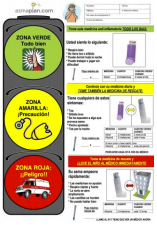July 31, 2014
Communication Barriers in Treating Childhood Asthma
The Link Between Effective Asthma Action Plan Communication and Health Outcomes for Hispanic Families with Language Barriers
Effective communication is critical to managing health conditions, especially in emergency situations. For families with “limited English proficiency (LEP), communication barriers may result in serious health problems. Recent research supported by a Child Health Innovation Grant Award, found this is particularly true for children with asthma.
INSPIRAR or the Impact of Native Spanish on Plan Implementation & Responsiveness: Asthma Research is the title of research efforts led by Antonio Riera, an Assistant Professor of Pediatric Emergency Medicine at Yale, to identify and more effectively address communication barriers in asthma care. The project was supported by a two year Child Health Innovation Grant Award from the Children’s Fund of Connecticut and the Yale Center for Clinical Investigation (2011-2013). During this time, qualitative research was conducted using semi-structured interviews and focus groups to learn from LEP Latino caregivers’ experiences with asthma health communication. The research found that language issues led to:
The research also indicated that families place a high value on having an understandable action plan and access to learning opportunities for understanding the asthma process, medication delivery, managing symptoms and ways to access additional resources. Based on this feedback, INSPIRAR recruited a multidisciplinary team of experts and worked with JUNTA for Progressive Action in New Haven to develop educational tools for LEP Hispanic caregivers.
JUNTA hosted an asthma education fair for LEP caregivers where trained clinicians provided language concordant instruction on medication recognition and administration, peak flow use and action plan comprehension. A validated quality of life questionnaire was administered and revealed statistically significant improvement in caregiver quality of life three months after the education fair and lower reported rates of asthma-related school absenteeism after six months.
 INSPIRAR developed www.asmaplan.com, a website in Spanish designed to disseminate both educational content and provide easy access to asthma resources. The site provides instructional videos and visual action plans tailored to three treatment “zones” defined by the severity of a child’s condition. These plans use principles of comprehensible communication which include images of actual medications, icons and colors to aid in communicating complex concepts. There is a dedicated page to connect families to state-funded programs and other existing resources. The site also provides embedded links to English translations that enable navigation by health care providers.
INSPIRAR developed www.asmaplan.com, a website in Spanish designed to disseminate both educational content and provide easy access to asthma resources. The site provides instructional videos and visual action plans tailored to three treatment “zones” defined by the severity of a child’s condition. These plans use principles of comprehensible communication which include images of actual medications, icons and colors to aid in communicating complex concepts. There is a dedicated page to connect families to state-funded programs and other existing resources. The site also provides embedded links to English translations that enable navigation by health care providers.
Going forward, INSPIRAR plans to investigate and evaluate the use of other types of internet capabilities and mobile media as a means of disseminating asthma education to LEP caregivers.
The INSPIRAR Project is particularly important for children in Connecticut where asthma rates are higher than the national average. According to the most recent Connecticut Health Care Survey, 13% of children in the state suffer from asthma compared to a national average of 9.3%. National statistics also suggest a much higher incidence of asthma in Hispanic households both nationally and in Connecticut, with pediatric emergency department visits in Connecticut on the rise for Hispanic children. In addition to a higher incidence of emergency visits, Hispanic households with children experiencing asthma tend to exhibit lower rates of action plan use for the treatment of asthma and for adherence to a medication plan.
INSPIRAR’s identification of language proficiency as a barrier to health care is also consistent with findings issued by the recent Connecticut Health Care Survey. Analysis of Survey findings by the Child Health and Development Institute (CHDI) the operating arm of the Children’s Fund of Connecticut - one of the Survey’s sponsors - found parents reported a lack of child health provider understanding as one of their barriers to keeping their children healthy. Addressing non-medical barriers to care such as language or transportation is critical to maximizing the contribution of health services to children’s overall well being. The medical home model of care, which is growing throughout Connecticut, helps providers and families address these barriers to care.
For more information, please contact Antonio Riera at antonio.riera@yale.edu . For more information on CHDI’s work to expand the medical home model of care throughout Connecticut, please see Issue Brief 14: Medical Homes: The Transformation of Pediatric Primary Care in Connecticut (8/13/12) or contact Lisa Honigfeld at honigfeld@uchc.edu.